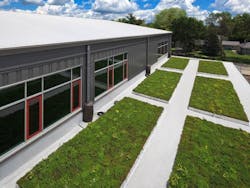When it comes to pursuing a LEED certification, the roof can lead to a treasure trove of credits. It’s an element of a building that lends itself to a variety of LEED credit categories, including energy and atmosphere, water efficiency, and materials and resources.
“In the bigger picture, roofing gives all kinds of access points to LEED certification,” says Wes Sullens, director of codes technical development and materials and resources for LEED.
For example, the green building certification awards credits to roofs that are vegetated. A vegetated roof can then lead to such credits as storm water management and promoting habitat and biodiversity. A roof that has a high solar reflectance index (SRI) value can earn a credit for reducing the building’s heat island effect, which can lead to a credit that rewards lowering your energy usage.
When planning improvements or repairs to your roof, consider these green upgrades that could further your competitiveness for LEED certification.
1. Reflective/Cool Roof
Cool roofs are designed to absorb less heat and reflect more sunlight than a standard roof. They’re usually made of a highly reflective type of paint, sheet covering, or highly reflective tiles or shingles, according to the U.S. Department of Energy.
Benefits of a cool roof include:
- Lowering your energy bills, since it can reduce the need for air conditioning
- Extending the service life of your roof
- Reducing local air temperatures (heat island effect)
- Helping prevent power outages by lowering peak electricity demand
- Reducing power plant emissions such as carbon dioxide and sulfur dioxide
“If you are using roof materials that have a good reflectance value, you’re set to be awarded this credit,” says Karema Seliem, who oversees technical development of the Sustainable Sites credit category in the LEED rating system.
Buildings can earn a credit for reducing the heat island effect with a high-reflectance roof, but it depends on the type of roof. For LEED v4 in existing buildings, low-sloped roofs must have an initial SRI of 82 or a three-year aged SRI of 64. A steep-sloped roof must have an initial SRI of 39 or a three-year aged SRI of 32.
Cool roof coating products are available for most roof types, according to the Department of Energy. These are comprised of white or special reflective pigments that reflect sunlight well.
“For high-reflectance roofs, the materials require regular maintenance and cleaning, because the material can lose reflectivity over time,” Seliem explains.
2. EPDs and HPDs
A second way to earn LEED credits from your roof is being transparent about what’s in the roofing materials you use.
“We have credits for the evaluation of products,” says Sullens. “Is it a low-carbon material? Are raw materials harvested in a sustainable way?”
One form of evaluation is an environmental product declaration (EPD). These declarations mean that a third party has verified the product’s lifecycle impacts. These impacts are based on the product’s lifecycle assessment, which might include information on how raw materials are sourced; shipping and transportation modes of the materials; installation onsite; its use and maintenance; and eventually its recycling, disposing of or repurposing the product at the end of its life.
The health product declaration (HPD), on the other hand, reports the material contents of building products and the health effects associated with these materials, according to the USGBC. A HPD can disclose potential concerns of certain chemicals that might be in some products—and therefore protect your occupants from being exposed daily to such hazardous materials.
3. Renewable energy
Using your roof to install renewable energy systems, such as solar panels, can earn your building LEED points. A structural engineer verification can let you know if your roof can support the design and construction of solar panels. Renewable energy can lead to more LEED credits by reducing your energy usage.
When considering solar panels for your roof, make sure verification looks at such factors as load-carrying capacity, the slope of the roof, building height, wind and seismic loads, and the age and condition of the roof.
4. Vegetated/green roofs
A green roof is an ideal way to earn LEED credits, because it can be something your occupants can take advantage of and use. Green roofs are another way to turn your roof into a cool roof (and lower the heat island effect) and can also promote biodiversity for the surrounding environment.
“A lot of motivation for green roofs that we’ve seen is really about heat reduction and stormwater reduction,” says Sullens.
Seliem adds, “You’ll see life flourish on your roof afterward. Being aware that it can also be a good habitat is good to know.”
A structural engineer verification should also let you know if your system can support retrofitting for a green roof, especially if you want to allow occupants to walk through it.
“It’s something that can be usable for occupants,” Sullens says. “That’s always preferred. It promotes wellbeing and allows them to feel more connected to their space.”
Credit Now and in the Future
When pursuing a LEED certification for your building, look toward the roof for potential credits. Some of these updates can contribute to other indirect credits (like lowering your energy usage)—and the opportunity to say that your building is sustainable, cost-effective and healthy for your occupants.
Two handpicked articles to read next:
About the Author

Sarah Kloepple
Associate Editor
Sarah joined the BUILDINGS team as an associate editor in August 2018. She is a graduate of the Missouri School of Journalism, where her focus was magazine writing. She's written and edited for numerous publications in her hometown of St. Louis.
